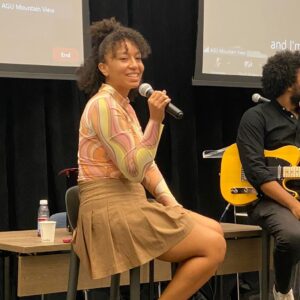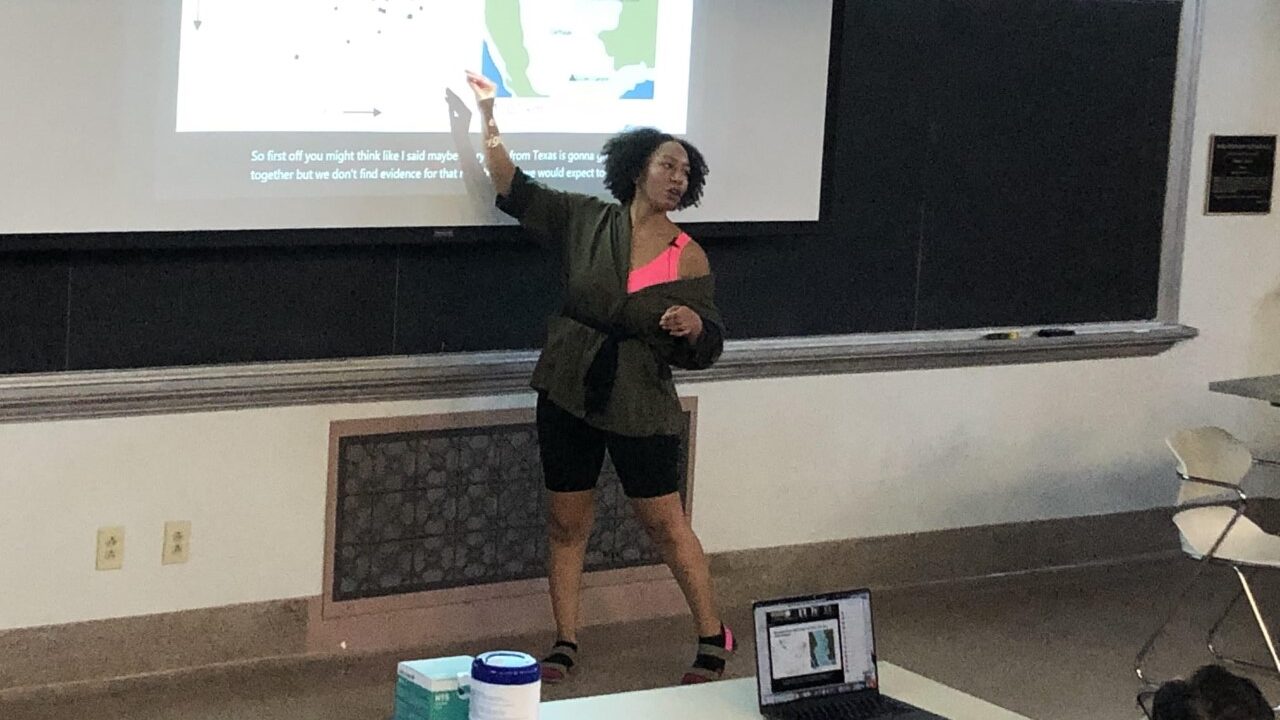For most people, microbes are something to be observed under a microscope, but for Dr. Raquel Bryant, Assistant Professor of Earth and Environmental Science, they provide insight into the way that the world around us works.
“Collective action is actually possible,” Bryant said, “this is something I learned from microbes.”
Strength in numbers is something that Bryant, who studies deep time interactions between life, the ocean, and the climate, sees as an essential principle of both activism and science.
Professor Bryant describes her work as setting foot into a time machine and going back 100 million years to study something that still looks remarkably similar in our current era: microfauna in the oceans. She specifically studies the unicellular organisms called foraminifera, a protist that has been on the planet for roughly 500 million years. What makes these organisms so fascinating, according to Bryant, is that they record environmental conditions in their shells. In other words, we can analyze the fossilized shells of foraminifera to learn more about marine environments of the past.
“[These organisms] are biomineralizers, so they use seawater to secrete the calcium carbonate shells that they make,” Bryant explained, “the chemistry of the water gets recorded in those shells and geochemists can then reconstruct sea surface temperatures using the geochemistry of foraminifera.”
In her lab at Wesleyan, Bryant studies communities of foraminifera to reveal information about our oceans. “What I usually [focus on] in my work,” Bryant explained, “is their communities, their assemblages. [It’s] their ecology that tells me about past oceans.”
You can read about her recent work on foraminifera assemblages in two recent articles in Paleobiology and Cretaceous Research.
Like many organisms, foraminifera have preferences for different types of environments. Some thrive in environments where there is almost no oxygen, while others live at the top of the water column and have photosymbionts.
“There are practical controls on their distribution so that when you look at them as a group, you can…reconstruct what the ocean was like back then,” Bryant explained.


But, as Bryant put it, science isn’t everything. In addition to questioning what we know about our planet’s past, Professor Bryant questions the inner workings of geology, and more broadly, science, as a discipline.
As an undergraduate at Brown University, Bryant was part of a group of PhD-bound students who designed a class called Race and Gender in the Scientific Community. They sought to address the challenges faced by people with marginalized identities pursuing graduate programs in the US.
“[We were seeking to] arm ourselves with knowledge, so we [could be] aware of some of the difficulties and barriers that we might face before getting into our PhDs,” Bryant explained.
Ultimately, Bryant and her classmates found themselves grappling with big questions. Why, they wondered, was the field of science so exclusive? And what are the historical, sociological, and psychological reasons that bar access to the field?
Bryant understood that there would never be one perfect PhD program for her and that finding a program that suited her would be an active and ongoing process. The work she did at Brown as both a geology student and an activist led her to choose the University of Massachusetts, Amherst for her graduate studies.
At UMass, Bryant joined the Graduate Women in STEM organization, and started working on the “Safe at Work” campaign, an initiative with the goal of confronting sexual harassment on campus. They aimed to reframe the issues of sexual harassment and sexual violence in STEM education as a workplace safety issue. This way, they could lobby for the implementation of tangible protocols that could be followed in an instance of sexual harassment.
“If you don’t store your chemicals [correctly] in your chem lab, you get your lab keys taken away. If there’s broken glass, there’s a protocol of how to clean it up and make sure no one gets hurt,” Bryant explained, “When sexual harassment happens in the lab, there’s no protocol. They don’t take away the harassers’ keys.”
The initiative fell at the intersection of advocacy and education, Bryant clarified.
“It was so transformative to be involved in an advocacy effort that united graduate women and men from different parts of campus,” Bryant explained. “And the whole experience taught me a lesson about the idea of incremental change.”
But Bryant was already familiar with the concept of incremental change because it was something that she had learned about in the lab.
“It’s a geoscience thing, too. We have this idea of gradualism where things like erosion happen slowly,” Bryant explained. “Think about a mountain slowly eroding, in which the little sediments are slowly accumulating in the bottom of the ocean.”
Both her geoscience research and advocacy work, however, taught her that change can also happen rapidly, under the right conditions.
“[In geoscience], we also see catastrophic events and big perturbations,” Bryant added. “Like the meteor that hit the Earth [and wiped out] the dinosaurs. Progress is a mix of both gradualism and catastrophism. Activism is like that too.”

At the same time as Dr. Bryant has been striving to become a great scientist and activist, she has also been honing her skills as a great leader. According to Bryant, being a good scientist goes hand in hand with being a good leader. She sees leadership as a drastically underdeveloped skill among scientists, something which she predicts will have wide-reaching consequences.
“Leadership is about understanding [one’s] own privileges and being brave enough to leverage them in certain situations.” Bryant said. She believes that if we are willing to challenge the prevailing forms of leadership in science, we can reduce overrepresentation and elevate historically underrepresented groups. As opposed to under-representation in STEM, over-representation refers to the groups that are taking up too much space demographically in scientific spaces.
Bryant stresses that when it comes to the complex issues currently facing our society, the science needs to be communicated in a way that moves people to action. Scientific expertise cannot exist in a vacuum and a good scientist and leader is someone who can communicate their science and make it relevant to the lived experiences and daily lives of those around them.
This is why Bryant takes a holistic approach to her scientific work. This past summer, she co-convened an interdisciplinary conference on Justice in Geosciences (video available here) and in her spare time, she is a singer/songwriter and spends time learning from her colleagues in the studio art and theater departments on campus.
According to Bryant, visualizing small things like microbes is often only possible with art. “Not everybody has [access to] a telescope or a microscope,” Bryant said, “but art [can be] used to transport people to different [periods] in times, different scales, and different vantage points.”
If tomorrow, science as a discipline ceased to exist, Bryant says she would be totally fine.
“There are a lot of things I want to do with my life and [in a world without science] the thinking that has been inspired by my scientific [work] would still be valid, it would still be helpful for navigating the world and how it works.”


